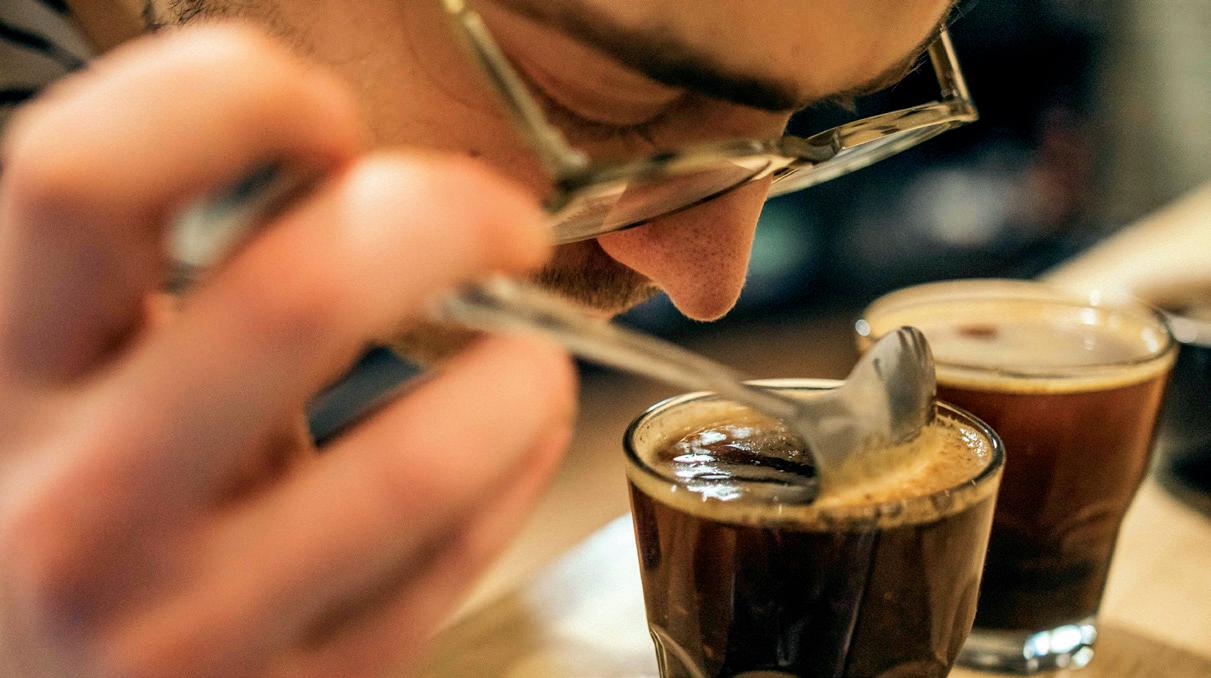
4 minute read
Kiwi Craft Coffee
Kiwi Craft Coffee: The Little Guys are Becoming the Key Players
The global pandemic has disrupted supply chains for almost every aspect of foodservice, including coffee, and climate change is threatening the areas coffee is typically grown. Both these factors are contributing to the rise of smaller, batch roasters who are providing unique sensory experiences with their highquality coffee and close relationships with the farmers they work with, and more New Zealand cafe´s are turning to small, local roasters over the larger players.

Innovative work is also being done on how to best sustain the coffee industry for generations to come, from working with new coffee species to incorporating Artificial Intelligence into coffee bean tasting.
Rediscovering Forgotten Wild Coffee Species
According to research from CIRAD, a French agricultural research centre, and the Royal Botanic Garden in Kew, the coffee sector can look to forgotten wild coffee species to mitigate the global impact of climate change.
While Robusta and Arabica make up more than 99 percent of all coffee production, there are more than 120 other species that have been identified within the Coffea genus. The flip side of the success of species like Robusta, which started to emerge as a dominant variety in the early 1900s, was that lesser-known coffee species were increasingly abandoned and forgotten.
Recently there has been a renewed interest in such species. Climate change poses a significant threat to coffee farmers worldwide and Robusta’s dominance is under threat. Scientists predict that as much as 60 percent of land used for cultivation of the current coffee species could be affected by climate change by 2050.
CIRAD has been working with the Royal Botanic Gardens in Kew, UK to identify the most promising wild coffee species. Researchers have focused their efforts on three Coffea species that are relatively unknown: stenophylla, brevipes and congensis. These are of interest because of historical reports of a superior taste, but also because they are found in Upper West Africa at relatively low elevations, suggesting the potential for climate resilience.
“Coffea affinis and C. stenophylla may possess useful traits for coffee crop plant development, including east differentiation, disease resistance and climate resilience,” explained researchers from Kew.
“These attributes would be best accessed via breeding programs, although the species may have niche-market potential via minimal domestication.” In December last year, 15 experts gathered at CIRAD’s sensory analysis laboratory, with four more virtual attendees from Switzerland, the Netherlands and Belgium to taste the three species together, representing a world first.
“The aroma profile of new coffees looks promising,” noted Morgane Daeschner, a Q-grader (an internationally recognised professional credential that confirms the holder’s ability to grade and score coffee).
All tasters agreed that it was a historic moment in the journey to find new coffee varieties with the potential for each of the coffee species to be grown independently or crossed with other species, such as Robusta, to create new, more robust, and higheryielding varieties.
Replicating Coffee Cupping with Artificial Intelligence
Agriculture and food tech startup, Demetria, has pioneered the automated analysis of coffee bean tasting using Artificial Intelligence (AI) and data cloud technology.
Coffee tasting, or coffee ‘cupping’, is the process by which characteristics of a coffee bean are evaluated. Not dissimilar to conventional sensory panel, when cupping, experts check a particular bean’s fragrance, aroma, acidity, body, flavour, and finish.
According to Demetria, this manual method is expensive and time consuming, and is predominately carried out by industry experts outside the origin countries. This can mean roasters and traders have minimal visibility into the quality of the beans they purchase until they are exported.
The start-up has also raised concerns that cupping is inaccessible to a majority of coffee farmers, notably the 12.5 million smallholders who produce 60 percent of the world’s coffee beans. Consequently, growers are unable to determine or manage the quality of the crop. “Farmers’ inability to guarantee a consistent level of quality of beans mean that a significant number of them receive just a base commodity price for their produce,” commented Demetria.
The food tech company says it has the answer.
Demetria is leveraging near infrared (NIR) sensors to analyse and fingerprint green coffee beans for biochemical markers. Its AI based platform, known as an e-Palate, then matches each bean profile according to the industry standard coffee flavour wheel. Quality and taste can now be assessed at any stage of the coffee production and distribution process.
“The ability to discover the quality of green coffee beans is a game changer for an entire industry that’s relied on a primitive supply chain and artisanal processes for 300 years,” noted Demetria co-founder and CEO Felipe Ayerbe. “Our technology delivers vital intelligence to ensure crop consistency and quality control, resulting in readdressing the economics of the coffee value chain to benefit every key player.”
The company has also forged a working relationship with the Columbian National Federation for Coffee Growers (FNC). Together, they are developing a series of smartphone apps designed to help farmers and their transaction points enhance traceability in the supply chain. Ultimately, the goal is to better control and track bean quality to ensure it is priced appropriately.
“Through the use and affordable democratisation of sensors, cloud computing and other technologies, coffee growers will be able to manage each stage of the production process in a simple, timely and accurate manner, and, more importantly, evaluate the quality of their own crop and gain a price that reflects this,” expressed FNC President Roberto Velez.
“Technologies like Demetria empower the FNC to achieve its goals and play a key role in the sustainability of our industry.”










